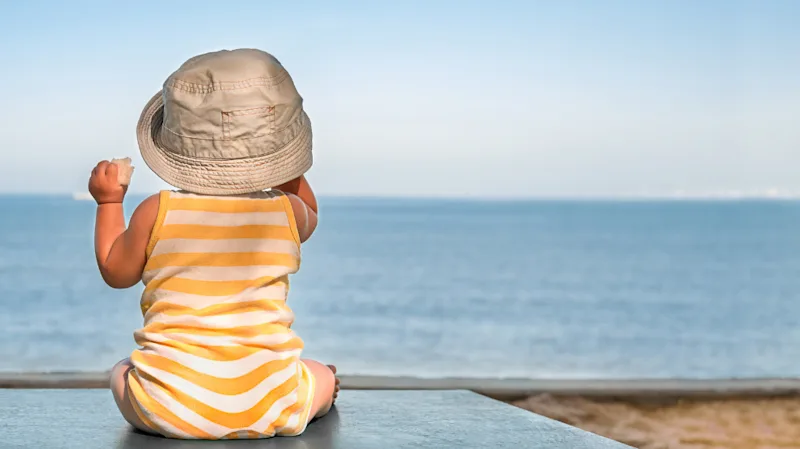As parents, we are often bombarded with advice on how to best care for our children. One critical area of concern, especially during sunny months, is the importance of sunscreen. Proper sun protection is vital to safeguard our little ones from the harmful effects of UV radiation. Here, we will explore the different types of sunscreens, their safety, and why they are essential for children and babies.
Understanding the Risks
“There is clear evidence that sunlight can cause skin cancers,” says neuroscientist Andrew Huberman. While the types of skin cancers caused by the sun are not typically the deadliest, sun exposure is a significant factor in skin aging and damage. Sunburn is an immune response to too much sun, not a direct indicator of cancer, but it does highlight the skin’s vulnerability to UV damage.
So, why should we care, how do we protect our children in the sun, and what do we need to know about suncreens?
Types of Sunscreens
Mineral-Based Sunscreens
Mineral-based sunscreens, also known as inorganic sunscreens, contain ingredients like zinc oxide and titanium dioxide. These act as physical barriers, reflecting UV light away from the skin. These sunscreens are generally considered safe, especially for babies and young children, as they do not penetrate the skin. Most mineral sunscreens are effective at concentrations of 10-25%, with 25% being on the higher end.
Advantages:
- Reflects UV light rather than absorbing it.
- Less likely to cause skin irritation or allergic reactions.
- Safe for all ages, including babies under six months.
Poppylist’s Top 5 Mineral-Based Sunscreens for Children Under 6 Months:
- Babo Botanicals Sensitive Baby Mineral Sunscreen Lotion, SPF 50: Contains 20% zinc oxide. Buy on Amazon
- Earth Mama Baby Mineral Sunscreen Lotion, SPF 40: Contains 25% zinc oxide. Buy on Amazon
- Thinkbaby Clear Zinc Sunscreen Lotion, SPF 30: Contains 20% zinc oxide. Buy on Amazon
- Badger Baby Mineral Sunscreen Cream, Chamomile & Calendula, SPF 40: Contains 22.5% zinc oxide. Buy on Amazon
- ATTITUDE Baby Oatmeal Sensitive Natural Mineral Sunscreen Lotion, Unscented, SPF 30: Contains 20% zinc oxide. Buy on Amazon
Did you see our Instagram video for the ultimate sunscreen application hack? Here’s the Roll on Sponge you’ll want to purchase alongside the sunscreen!
Chemical Sunscreens
Chemical sunscreens, also known as organic sunscreens, contain compounds like oxybenzone and avobenzone that absorb UV light. These can be more convenient to apply and often blend well with makeup. However, there is substantial evidence that these chemicals can act as endocrine disruptors, especially with frequent use. This makes their use controversial, particularly for babies and young children.
Disadvantages:
- Absorbs into the skin and bloodstream.
- Potential endocrine and hormone disruptors.
- Not recommended for children under six months due to the thin and sensitive nature of their skin.
Best Practices for Sun Protection
1. Use Physical Barriers: Clothing, hats, and sunglasses are effective at blocking UV rays and are the safest form of protection. Physical barriers do not carry any risk of chemical exposure.
2. Opt for Mineral-Based Sunscreens: For children, especially those under six months, mineral-based sunscreens are the preferred choice. They provide effective protection without the risk of chemical absorption.
3. Avoid Peak Sun Hours: Try to keep children out of direct sunlight between 10 AM and 4 PM when UV radiation is strongest.
4. Apply Sunscreen Properly: Ensure that sunscreen is applied 15-30 minutes before sun exposure and reapply every two hours, or more frequently if swimming or sweating.
5. Check for EWG Verification: The Environmental Working Group (EWG) verifies products that meet strict health and safety standards. Look for sunscreens with the EWG VERIFIED® mark to ensure they avoid harmful ingredients and provide full transparency of their components.
Sunscreen Alone Is Not Enough
While sunscreen is an essential tool in protecting your child's skin from UV damage, it's not the only line of defense. Here are some additional tips to ensure comprehensive sun protection:
Wear Clothes: Dress your children in lightweight, long-sleeved shirts, pants, and wide-brimmed hats to cover as much skin as possible. Clothing provides a physical barrier that significantly reduces UV exposure.
Plan Around the Sun: Try to schedule outdoor activities in the early morning or late afternoon when the sun's rays are less intense. Avoid being outside between 10 AM and 4 PM, when UV radiation is at its peak.
Find Shade – or Make It: Whenever possible, seek out natural shade under trees or use umbrellas and tents to create your own. This reduces direct exposure to the sun's harmful rays.
Check the UV Index: Before heading outside, check the daily UV index to gauge the strength of the sun’s rays. A higher UV index means greater potential for skin damage and necessitates stronger protective measures.
Sunglasses Are Essential: Protect your child's eyes with sunglasses that block 100% of UV rays. This prevents UV damage to the eyes and the delicate skin around them.
Don't Get Burned: Teach your children the importance of avoiding sunburn. Frequent sunburns, especially in childhood, significantly increase the risk of skin cancer later in life. Emphasize the need for regular sunscreen application and other protective measures to prevent burns.
By incorporating these strategies along with the regular use of sunscreen, you can provide robust protection for your child's skin and help instill lifelong habits of sun safety.
Ready to get outside?
Protecting your children from the sun’s harmful rays is crucial for their long-term health. While sunburn does not directly equal skin cancer, the cumulative damage from UV exposure can have significant adverse effects. Mineral-based sunscreens are the safest and most effective option for children and babies, offering a reliable means to shield their delicate skin. Remember to combine sunscreen use with other protective measures such as clothing and shade, and always stay informed about the products you use on your family’s skin.
By taking these precautions, you can enjoy sunny days with peace of mind, knowing your children are well-protected from the dangers of UV radiation.


